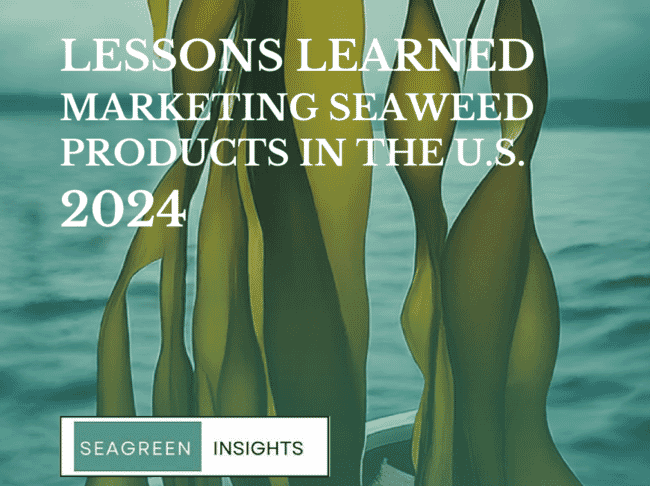
The report, called Lessons learned marketing seaweed products in the US, captures the successful approaches existing seaweed producer and support organisations are employing to drive sales and growth of seaweed products in the US.
The report builds on previous research on consumer perceptions and the use of “willingness to purchase” models with an intention to evolve from a theoretical measure of interest to one that documents real approaches in branding, product development and sales channels that has resulted in consumer sales.
"We hope this report will contribute to the growing body of research on seaweed markets while accelerating the learning curve for startups and organisations supporting their growth," Mike Blakeley, Seagreen Insights’ co-founder, told The Fish Site.
The report comes at a critical time as the seaweed industry in the US seeks to grow, with more cultivation and product innovation. Entrepreneurs and investors, as well as existing companies, will benefit form the report’s rich content that was provided by over 25 professionals in the US seaweed industry – including farmers, producers and industry support entities. It is envisioned that the report will help seaweed producers expedite their sales efforts and avoid mistakes that other companies have experienced.
Key findings
- What to call it? The most common term across product categories is simply “seaweed”. However, many producers felt strongly that products should be named based on the variety or species of seaweed utilised. For example, in the US many food products are derived from “kelp” and producers felt that using that term was important to differentiate their product from other food-grade species, like “nori” or “gim.”
- Efficacy and performance: Many producers find success in marketing the performance and efficacy characteristics of seaweed, especially relative to other synthetic or plant-based alternatives. In such cases, the marketing message is really about performance, and not other benefits that seaweed has, such as a “climate friendly” resource. This holds true more so for B2B sales channels which are using seaweed as an input.
- Restaurant/chef partnerships: Establishing partnerships with restaurants or individual chefs was identified as a critical opportunity for any seaweed-based food product. Some producers have partnered to create products, recipes and menus in an attempt to win new consumers who might otherwise not know how to use seaweed in meals.
- Traceability and food safety: The need to assure customer (consumer) safety is critical. Globally the seaweed sector has been working to establish safety protocols for commercial seaweed products. However, there are not widely recognised certification or labeling schemes meaning producers are integrating safety messages into their marketing efforts.
- Retail sales channels: Producers agreed the most difficult sales channel was brick and mortar grocery retail. The demanding nature of supplying regional/national chain stores, along with competition from other products/brands was among the most difficult challenges for producers. Many producers went through “growing pains” to supply these customers but acknowledge their importance to achieve volume sales.
The report also asked each participant about the major needs to support their marketing and sales efforts. The top responses were:
- Industry representation: seaweed producers are looking for trade association and industry representation for marketing and regulatory advocacy.
- Funding opportunities for marketing/sampling events: seaweed industry companies have limited access to public funding for marketing activities relative to other seafood and agriculture programs.
- More data: tracking industry harvest, production and end market sales is complicated but some tools are emerging. More are needed.
- Customer/consumer feedback: producers don’t have good or obvious tools to obtain feedback from customers. Cheap and efficient ways to obtain customer/consumer feedback is critical to ongoing product development.




